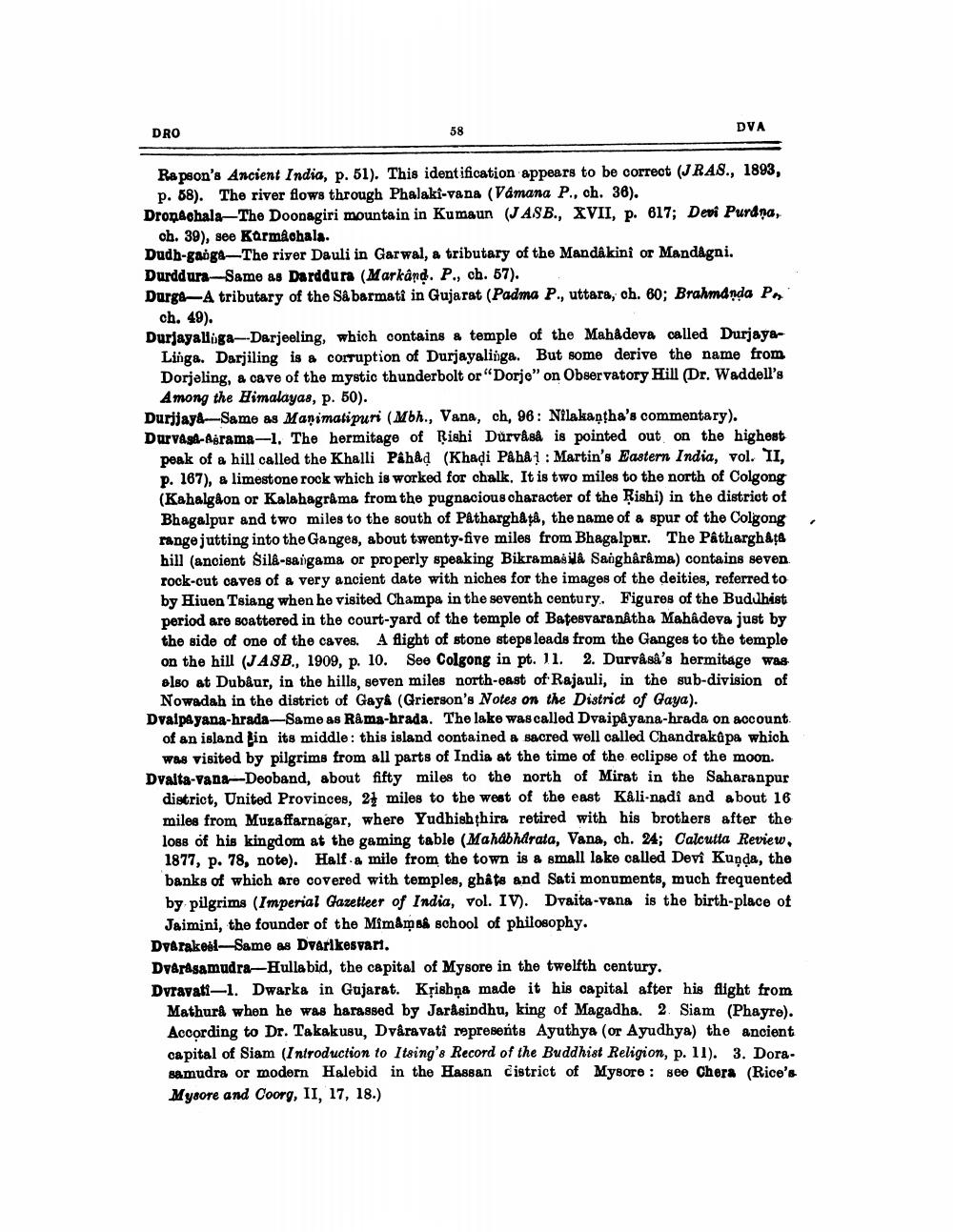________________
DRO
58
DVA
=
Rapson's Ancient India, p. 51). This identification appears to be correct (JRAS., 1893,
p. 58). The river flows through Phalaki-vana (Vamana P., oh. 36). Dronachala—The Doonagiri mountain in Kumaun (JASB., XVII, p. 617; Devi Purdna,
ch. 39), see Karmachala. Dudh-gaga-The river Dauli in Garwal, a tributary of the Mandakini or Mandagni. Durddura-Same as Darddura (Markand. P., ch. 57). Durga-A tributary of the Så barmati in Gujarat (Padma P., uttara, ch. 60; Brahmanda Pn
ch. 49). Durjayalliga--Darjeeling, which contains a temple of the Mahadeva called Durjaya
Linga. Darjiling is a corruption of Durjayalinga. But some derive the name from Dorjeling, a cave of the mystic thunderbolt or "Dorje" on Observatory Hill (Dr. Waddell's
Among the Himalayas, p. 50). Durijay -Same as Manimatipuri (Mbh., Vana, ch, 96: Nilakantha's commentary). Durvasi-Asrama-1. The hermitage of Rishi Durvis& is pointed out on the highest
peak of a hill called the Khalli Pahad (Khadi Påhå! : Martin's Eastern India, vol. II, P. 167), a limestone rock which is worked for chalk. It is two miles to the north of Colgong (Kahalgaon or Kalahagrama from the pugnacious character of the Rishi) in the district of Bhagalpur and two miles to the south of Patharghata, the name of a spur of the Colgong range jutting into the Ganges, about twenty-five miles from Bhagalpar. The Patharghata hill (ancient Sile-saigama or properly speaking Bikramas Na Sanghârâma) contains seven rock-cut caves of a very ancient date with niches for the images of the deities, referred to by Hiuen Tsiang when he visited Champa in the seventh century. Figures of the Buduhist period are soattered in the court-yard of the temple of Batesvaranátha Mahadeva just by the side of one of the caves. A flight of stone steps leads from the Ganges to the temple on the hill (JASB., 1909, p. 10. See Colgong in pt. 11. 2. Durvâsa's hermitage was also at Dubâur, in the hills, seven miles north-east of Rajauli, in the sub-division of Nowadah in the district of Gays (Grierson's Notes on the District of Gaya). Dvalpa yana-hrada-Same as Råma-brada. The lake was called Dvaipayana-hrada on account
of an island in its middle: this island contained a sacred well called Chandraka pa which
was visited by pilgrims from all parts of India at the time of the eclipse of the moon. Dvaita-vana-Deoband, about fifty miles to the north of Mirat in the Saharanpur
district, United Provinces, 27 miles to the west of the east Kali-nadi and about 16 miles from Muzaffarnagar, where Yudhish thira retired with his brothers after the loss of his kingdom at the gaming table (Mahabharata, Vana, ch. 24; Calcutta Review, 1877, p. 78, note). Half a mile from the town is a small lake called Devi Kuqda, the banks of which are covered with temples, ghats and Sati monuments, much frequented by pilgrims (Imperial Gazetteer of India, vol. IV). Dvaita-vana is the birth-place of
Jaimini, the founder of the Mimamsa school of philosophy. Dvarakel-Same as Dvarlkesvari, Dvarasamudra-Hullabid, the capital of Mysore in the twelfth century. Dvravati-1. Dwarka in Gujarat. Kpishņa made it his capital after his flight from
Mathura when he was harassed by Jaråsindhu, king of Magadha. 2. Siam (Phayre). According to Dr. Takakusu, Dväravati represents Ayuthya (or Ayudhya) the ancient capital of Siam (Introduction to Itsing's Record of the Buddhist Religion, p. 11). 3. Dorasamudra or modern Halebid in the Hassan čistrict of Mysoro : see Chora (Rice's Mysore and Coorg, II, 17, 18.)




